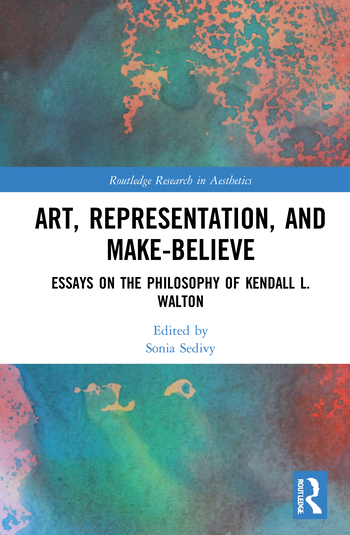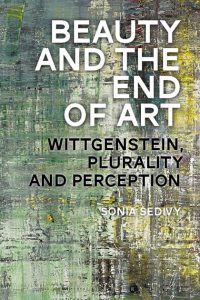Articles
Sonia Sedivy. “Introduction, The Reach of Make-Believe,” Art, Representation, and Make-Believe: Essays on the Philosophy Kendall L. Walton, Sonia Sedivy ed. Routledge, June 2021
Sonia Sedivy. “The Puzzle of Make-Believe About Pictures: can one imagine a perception to be different?”
Art, Representation, and Make-Believe: Essays on the Philosophy Kendall L. Walton, Sonia Sedivy ed. Routledge, June 2021
Sonia Sedivy. Draft: “Danto and Wittgenstein,” (pdf) The Blackwell Companion to Danto, Jonathan Gilmore and Lydia Goehr eds. Wiley Blackwell, 2021 forthcoming.
Sonia Sedivy. “Beauty and Aesthetic Properties: Taking Inspiration from Kant,” On Beauty, Wolfgang Huemer and Íngrid Vendrell Ferran eds. Munich: Philosophia Verlag, 2019, 9 – 25.
Sonia Sedivy. 2019. “Disjunctivism and Realism: Not Naïve but Conceptual.” In New Issues in Epistemological Disjunctivism. Edited by Casey Doyle, Joseph Milburn, Duncan Pritchard, 153-168. New York and London: Routledge 2019.
Sonia Sedivy. 2018. “Aesthetic Properties, History and Perception” British Journal of Philosophy: Art, History and Perception (Special Issue) 58(4): 345-362. doi.org/10.1093/aesthj/ayy039
Sonia Sedivy. 2014. “Art from a Wittgensteinian Perspective: Constitutive Norms in Context” Journal of Aesthetics and Art Criticism Vol. 72(1):67-82.
Sonia Sedivy. 2008. “Starting Afresh Disjunctively.” In Disjunctivism: Perception, Action and Knowledge. Edited by Adrian Haddock and Fiona Macpherson, 348-375. Oxford: Oxford University Press. (Starting Afresh Disjunctivism.pdf)
Sonia Sedivy. 2006. “Nonconceptual Epicycles.” European Review of Philosophy 6: 33-66. (Nonconceptual Epicycles.pdf) *new version with revised introduction will be available here shortly*
Sonia Sedivy. 2004. “Wittgenstein’s Diagnosis of Empiricism’s Third Dogma: Why Perception is not an Amalgam of Sensations and Conceptualization.” Philosophical Investigations 27(1) 1-33.
Sonia Sedivy. 2004. “Minds: Contents without Vehicles.” Philosophical Psychology 17(2): 149-179. (Minds Contents Without Vehicles.pdf)
Sonia Sedivy. 2004. “Wittgenstein Against Interpretation: “The Meaning of a Text Does Not Stop Short of its Facts.” In John Gibson Wolfgang Hummer eds. The Literary Wittgenstein. Routledge 165-185.
Sonia Sedivy. 1996. “Must Conceptually Informed Perceptual Experience Involve Non-Conceptual Content?” Canadian Journal of Philosophy 26(3) 413-431.
* Reprinted in Special Virtual Issue of Canadian Journal of Philosophy Top 22 Articles in the first 40 years, July 2013. <http://explore.tandfonline.com/page/ah/canadian-journal-of-philosophy
For more publications visit: http://philpapers.org/s/Sonia%20Sedivy
Books
 Art, Representation, and Make-Believe: Essays on the Philosophy of Kendall L. Walton.
Art, Representation, and Make-Believe: Essays on the Philosophy of Kendall L. Walton.
This is the first collection of essays focused on the many-faceted work of Kendall L. Walton. Walton has shaped debate about the arts for the last 50 years. He provides a comprehensive framework for understanding arts in terms of the human capacity of make-believe that shows how different arts – visual, photographic, musical, literary, or poetic – can be explained in terms of complex structures of pretense, perception, imagining, empathy, and emotion. His groundbreaking work has been taken beyond aesthetics to address foundational issues concerning linguistic and scientific representations – for example, about the nature of scientific modelling or to explain how much of what we say is quite different from the literal meanings of our words. Contributions from a diverse group of philosophers probe Walton’s detailed proposals and the themes for research they open. The essays provide an overview of important debates that have Walton’s work at their core. This book will be of interest to scholars and graduate students working on aesthetics across the humanities, as well as those interested in the topic of representation and its intersection with perception, language, science, and metaphysics.
Beauty and the End of Art: Wittgenstein, Plurality and Perception

Reviews
“This book is impressive for its command of the material, its scope, and its vision … Sedivy’s position is complex and subtle … Few books in recent years have made me think so much.” – Journal of Aesthetics and Art Criticism
“[An] important book: it significantly paves the way to a better understanding of objectivity in art and its logical coexistence with historicism; it reaffirms the inextinguishable presence of beauty in art and the correlated importance of perception in our engagement with, and accounts of, art; and that journey is made in the company of great thinkers.” – Notre Dame Philosophical Reviews
“This book offers a subtle and insightful exploration of connections between art, beauty and perception, as well as making a powerful case for the continuing importance of Wittgenstein in contemporary aesthetics.” – Peter Lamarque, Professor of Philosophy, University of York, UK.
“Much contemporary art and art theory seem to force us to choose between art that is hard-edged, conceptual, and political and art that is soft, absorbing, and pleasurable. By tracing how perception is interwoven with thought, feeling, and action, Sonia Sedivy compellingly shows us how to have it both ways and so how to understand and hold onto the human significance of artistic beauty.” – Richard Eldridge, Charles and Harriett Cox McDowell Professor of Philosophy, Swarthmore College, USA.